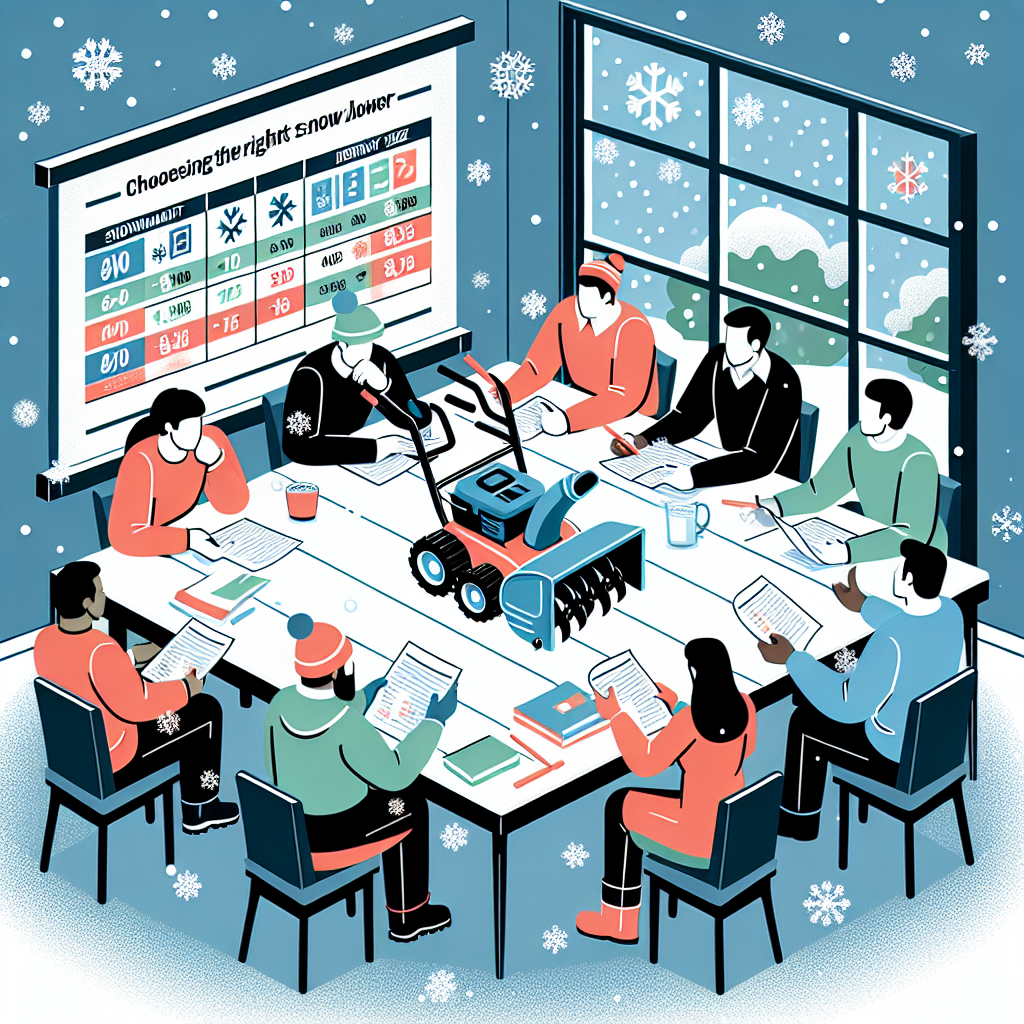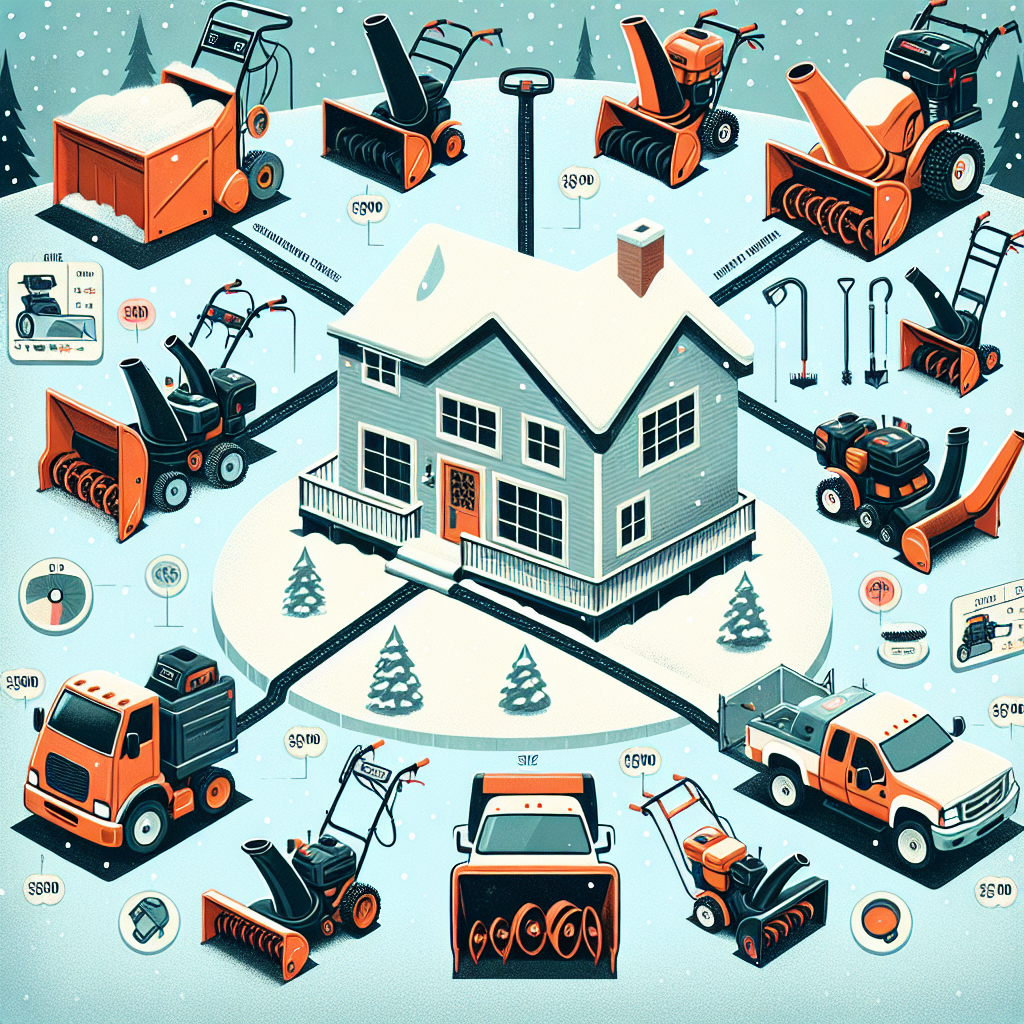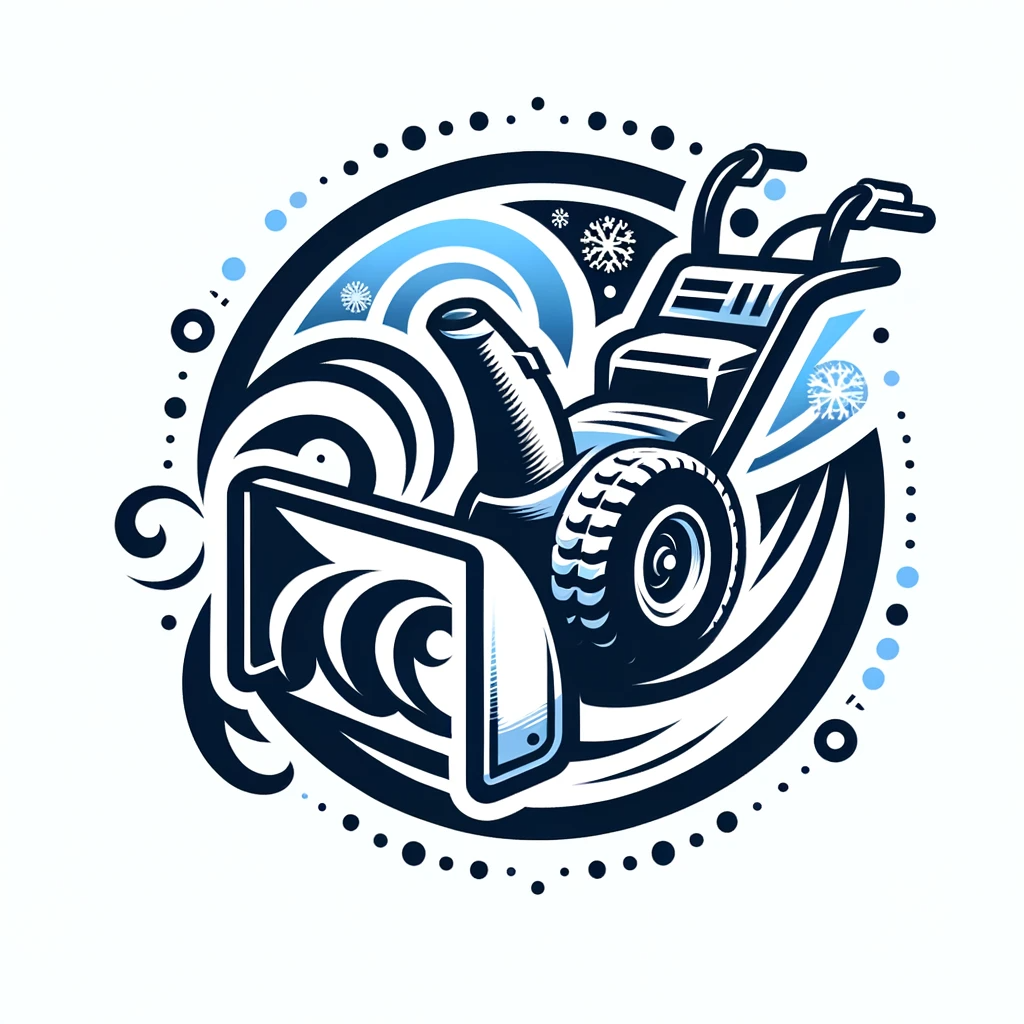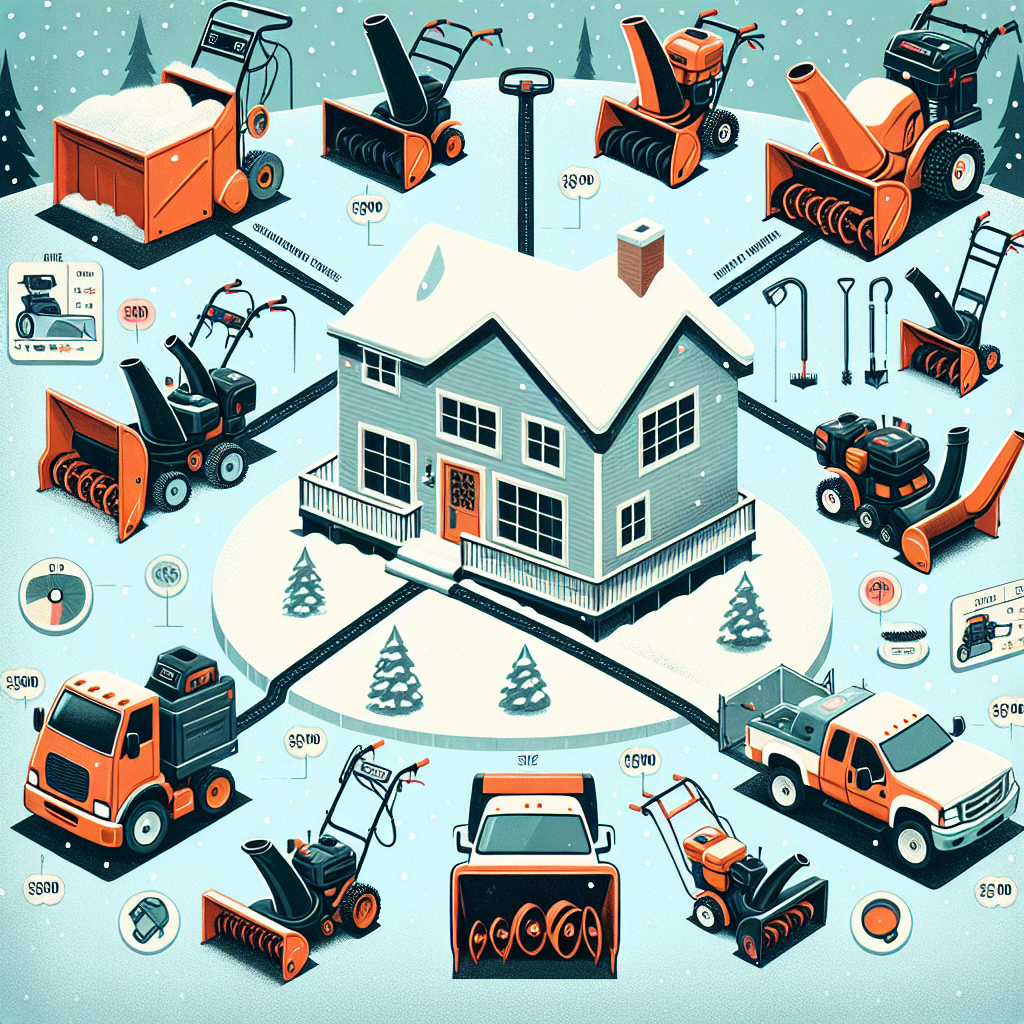Are you feeling overwhelmed by the numerous options for snow blowers available on the market? Look no further, as this article will guide you through the process of selecting the perfect snow blower for your needs. Winters can be harsh, and having the right snow blower can make all the difference in clearing your driveway efficiently and effectively. Let’s explore the key factors to consider when making this important purchase. Whether you’re a first-time buyer or looking to upgrade your existing snow blower, we’ve got you covered!

Factors to Consider
Budget
When it comes to purchasing a snow blower, one of the first factors you should consider is your budget. Snow blowers come in a wide range of prices, so it’s important to determine how much you are willing to spend. Keep in mind that higher-priced models often come with more powerful features and better durability, but there are also affordable options that can get the job done effectively.
Size of the Area
Another important factor to consider is the size of the area that needs to be cleared. If you have a small driveway or walkway, a smaller snow blower with a clearing width of around 20 inches may be sufficient. However, if you have a large driveway or live in an area with heavy snowfall, you may want to invest in a larger model with a wider clearing width.
Type of Snow
The type of snow in your area is also an important consideration. Wet, heavy snow can be more challenging to clear than light, fluffy snow. If you regularly experience heavy, wet snow, you may want to look for a snow blower with a more powerful engine and an auger designed to handle wet snow.
Frequency of Use
Consider how frequently you will be using your snow blower. If you live in an area with frequent snowfall, a durable and reliable model is essential. However, if you only expect to use the snow blower occasionally, a more basic and affordable option may be suitable.
Power Source
Snow blowers come in both gas-powered and electric models. Gas-powered snow blowers offer more power and are typically better suited for heavy-duty tasks. Electric snow blowers, on the other hand, are generally more lightweight and easier to maneuver. Consider your preferences and the availability of a power source when deciding between gas-powered and electric snow blowers.
Clearing Width
The clearing width refers to the width of the path that the snow blower can clear in a single pass. A wider clearing width means you can clear a larger area more quickly. However, it’s important to consider the size of your intended clearing area and any potential obstacles. A wider clearing width may be more challenging to maneuver in tight spaces.
Throwing Distance
The throwing distance refers to how far the snow blower can effectively throw the cleared snow. It’s important to consider the distance you need the snow to be thrown, as well as any nearby obstacles that may restrict the throwing distance. Some snow blowers offer adjustable throwing distances, allowing you to customize the range based on your needs.
Auger Type
The auger is the rotating mechanism that scoops up and throws the snow. Different snow blowers have different types of augers, such as rubber augers or steel augers. Rubber augers are generally better suited for clearing lighter snow, while steel augers can handle heavier, wetter snow. Consider the type of snow in your area and choose an auger type that matches your needs.
Weight and Maneuverability
The weight and maneuverability of a snow blower are important factors to consider, especially if you have a large area to clear or if you have physical limitations. Lighter snow blowers are easier to push and maneuver, but they may not have the same power as heavier models. Consider the weight of the snow blower and whether you are comfortable maneuvering it over snowy and icy surfaces.
Additional Features
Snow blowers come with a variety of additional features that can enhance their performance and convenience. Features such as power steering, electric start, speeds and reverse gear, headlights, and heated handles can make clearing snow a more comfortable experience. Consider which additional features are important to you and prioritize them when choosing a snow blower.
Choosing the Right Type
Single-Stage
Single-stage snow blowers are typically the most lightweight and affordable option. They use an auger to both scoop up and throw the snow in one motion. Single-stage snow blowers are best suited for light to moderate snowfall and are ideal for small areas such as sidewalks and driveways. However, they may struggle with heavy, wet snow.
Two-Stage
Two-stage snow blowers are more powerful and efficient than single-stage models. They have an auger that scoops up the snow and a separate impeller that throws the snow out of the chute. Two-stage snow blowers can handle heavier, wetter snow as well as larger clearing areas. They are often equipped with additional features such as power steering and adjustable speeds.
Three-Stage
Three-stage snow blowers are the most heavy-duty option and are designed for heavy snowfall and large areas. They have an extra accelerator that helps break up and propel the snow, making them even more efficient and powerful. Three-stage snow blowers are typically the most expensive option, but they offer superior performance and can handle the toughest winter conditions.
Gas-Powered Snow Blowers
Advantages
Gas-powered snow blowers offer several advantages. They typically have more power and can handle heavy, wet snow more easily compared to electric models. Gas-powered snow blowers also do not require a nearby power source, allowing for greater freedom of movement. Additionally, they are generally more durable and can handle larger clearing areas.
Disadvantages
Gas-powered snow blowers also have some disadvantages. They require regular maintenance, including oil changes and fuel refills. They can be louder and produce exhaust fumes, which can be a concern for both the user and the environment. Gas-powered snow blowers are also typically heavier and less maneuverable than electric models.

Electric Snow Blowers
Advantages
Electric snow blowers are a popular choice for smaller clearing areas and for those who prefer a more lightweight and user-friendly option. They are typically easy to start with the push of a button and require minimal maintenance. Electric snow blowers are also quieter and produce no emissions, making them a more environmentally friendly option.
Disadvantages
Despite their advantages, electric snow blowers have some limitations. They are generally less powerful than gas-powered models and may struggle with heavy, wet snow. Electric snow blowers also require a nearby power source, which may limit their range and maneuverability. Additionally, the length of the power cord can restrict movement and may require the use of extension cords.
Corded Electric Snow Blowers
Advantages
Corded electric snow blowers are lightweight and easy to maneuver, making them a popular choice for clearing smaller areas. They offer a hassle-free operation with no need for gas refills or battery charging. Corded electric snow blowers are also typically more affordable compared to their cordless counterparts.
Disadvantages
The main disadvantage of corded electric snow blowers is the limited range caused by the power cord. The length of the cord may restrict movement, and the use of extension cords can be cumbersome. Corded electric snow blowers also require a nearby power source, which may not be readily available depending on the layout of your property.
Cordless Electric Snow Blowers
Advantages
Cordless electric snow blowers offer the convenience of a gas-powered snow blower without the need for fuel or maintenance. They are portable and easy to maneuver, allowing for greater freedom of movement. Cordless electric snow blowers are typically lighter in weight than gas-powered models and are a suitable option for smaller to medium-sized clearing areas.
Disadvantages
The main disadvantage of cordless electric snow blowers is their limited battery life. Depending on the model, the battery may need to be charged frequently, which can be inconvenient if you have a larger area to clear. Cordless electric snow blowers also tend to be less powerful than gas-powered models and may struggle with heavy, wet snow.
Key Features to Consider
Clearing Width and Intake Height
The clearing width and intake height of a snow blower determine the width and depth of snow it can handle in a single pass. Consider the size of your clearing area and the typical snowfall in your area when choosing the appropriate clearing width and intake height for your needs.
Throwing Distance
The throwing distance refers to how far the snow blower can effectively throw the cleared snow. Consider the distance you need the snow to be thrown, as well as any nearby obstacles that may restrict the throwing distance. Some snow blowers offer adjustable throwing distances, allowing you to customize the range based on your needs.
Auger Type
The auger type determines how effectively the snow blower can handle different types of snow. Rubber augers are generally better suited for light, fluffy snow, while steel augers can handle heavier, wetter snow. Consider the type of snow in your area and choose an auger type that matches your needs.
Power Steering
Power steering can significantly improve maneuverability, especially for larger snow blowers. It allows for easier turning and maneuvering around obstacles, reducing the strain on the user.
Electric Start
An electric start feature allows for easy and convenient starting with the push of a button, eliminating the need for manual pulling of a starter cord.
Speeds and Reverse Gear
Having multiple speeds and a reverse gear can provide greater control and versatility when clearing snow. Different speeds allow you to adjust the pace to match the snow conditions and your own preference.
Headlight and Heated Handles
A built-in headlight can be incredibly useful when clearing snow during early mornings or late evenings when visibility is limited. Heated handles provide added comfort and warmth during colder weather.
Chute Control
Chute control allows you to adjust the direction and angle at which the snow is thrown. Look for a snow blower with easy and convenient chute control that allows for precise adjustment.
Warranty and Customer Support
Consider the warranty and availability of customer support when choosing a snow blower. A reliable warranty gives you peace of mind, and responsive customer support ensures you have assistance if any issues arise.
Top Snow Blower Brands
Toro
Toro is a well-known brand in the snow blower industry, offering a wide range of models suitable for different needs and budgets. They are known for their durable construction, powerful performance, and innovative features.
Ariens
Ariens snow blowers are highly regarded for their superior build quality and reliability. They offer a range of models, from single-stage to three-stage, designed to handle various snow conditions. Ariens is known for their powerful engines and efficient snow clearing capabilities.
Honda
Honda is a trusted name in the power equipment industry, and their snow blowers are no exception. Honda snow blowers are known for their exceptional performance, durability, and quiet operation. They offer a range of models with various features to suit different needs.
Husqvarna
Husqvarna offers a range of high-quality snow blowers designed for performance and durability. Their snow blowers are known for their powerful engines, ease of use, and user-friendly features. Husqvarna snow blowers are built to handle even the toughest winter conditions.
Cub Cadet
Cub Cadet snow blowers are known for their powerful performance and durability. They offer a range of models with different clearing widths and innovative features. Cub Cadet snow blowers are designed to handle heavy, wet snow and are suitable for various clearing areas.
Reviews and Ratings
Researching Customer Reviews
One of the best ways to gather insights and information about snow blowers is by researching customer reviews. Read reviews from actual users to get an idea of their experiences with specific models. Pay attention to common praises or criticisms, as this can help you determine the pros and cons of different snow blowers.
Reading Professional Reviews
Reading professional reviews from experts in the industry can provide valuable information about the performance, features, and overall quality of snow blowers. Look for reviews from reputable sources and compare the opinions and advice of multiple experts.
Comparing Ratings and Rankings
Several organizations and publications offer ratings and rankings for snow blowers. Consider these ratings and rankings to get an overview of the best models on the market. Take note of the criteria used in the ratings to ensure they align with your specific needs and preferences.
Final Considerations
Price vs Quality
While budget is an important consideration, it’s essential to strike a balance between price and quality. Investing in a higher-quality snow blower may cost more initially, but it can provide better performance and durability in the long run. Consider the long-term value and choose a snow blower that fits your budget while still meeting your needs.
Safety Features
When operating a snow blower, safety should be a top priority. Look for models that offer important safety features such as an auger safety switch, a chute control lock, and a reliable operator presence control. These features can help prevent accidents and ensure safe operation.
Availability of Parts and Service
Consider the availability of parts and service for the snow blower you are considering. Choose a brand and model that has a strong network of authorized service centers and readily available parts. This ensures that you can easily find support and replacement parts if needed.
Long-term Investment
When purchasing a snow blower, consider it as a long-term investment. Look for models with a good reputation for durability and reliability, and choose a brand that is known for producing high-quality products. A well-maintained snow blower can last for many years, providing you with reliable snow clearing for seasons to come.
By considering factors such as budget, size of the area, type of snow, power source, clearing width, throwing distance, auger type, weight and maneuverability, additional features, and key features like clearing width and intake height, throwing distance, auger type, power steering, electric start, speeds and reverse gear, headlight and heated handles, chute control, warranty and customer support, you can make an informed decision about which snow blower is right for you. Researching top brands like Toro, Ariens, Honda, Husqvarna, and Cub Cadet, reading customer and professional reviews, and comparing ratings and rankings can further assist in choosing the best snow blower for your needs. Finally, considering aspects such as price vs quality, safety features, availability of parts and service, and viewing the purchase as a long-term investment will ensure that you make the best decision for your snow clearing needs. Stay warm and breeze through winter with a reliable snow blower by your side.

